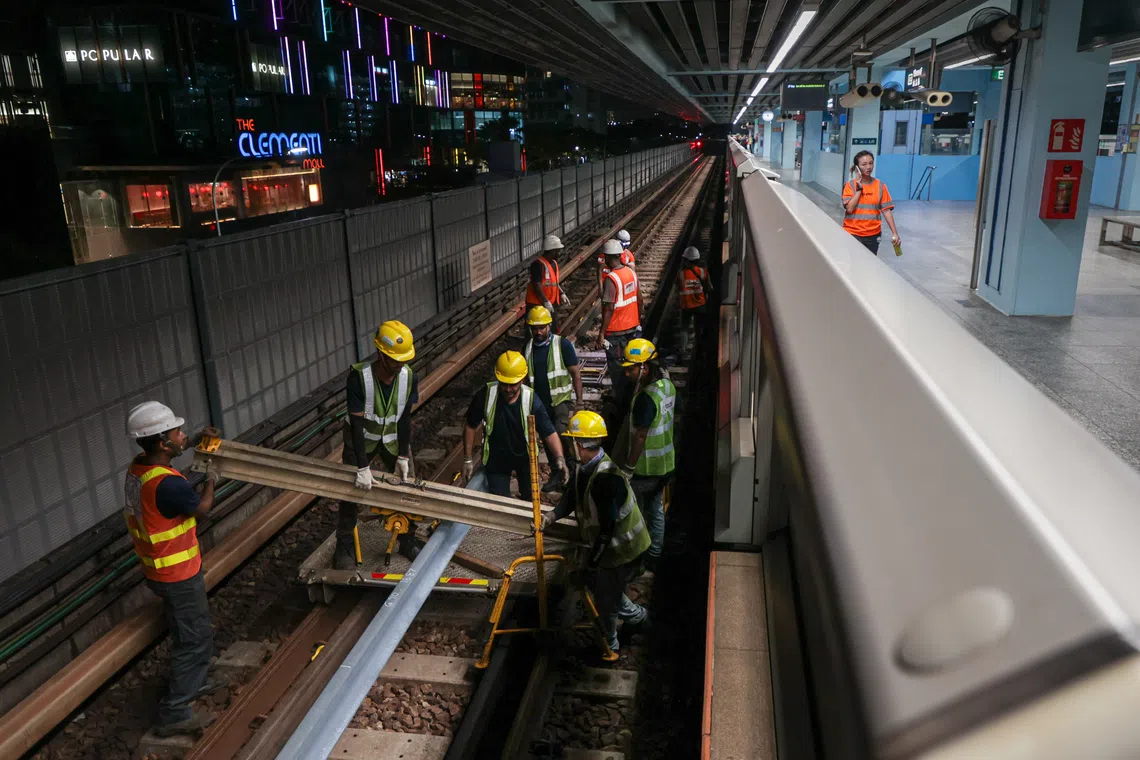SINGAPORE – The Land Transport Authority (LTA) plans to install systems to detect the overheating of axle boxes – the undercarriage components linked to the wheels – on trains across all existing MRT lines and the upcoming Jurong Region Line.
The axle box, which houses the bearings and connects the wheels to an axle rod, was at the centre of a major rail disruption in 2024.
On Oct 31, LTA launched a tender on government procurement portal GeBiz for the supply of hot axle box detection systems. The tender will close at 4pm on Jan 2, 2026.
The Cross Island Line, which will be ready from 2030, is not included in the tender as it is still under construction. The Jurong Region Line will open in phases from 2027 to 2029.
Installing such systems was identified as a measure to detect potential axle bearing failures early, after one such failure caused a
six-day disruption to services on the SMRT-operated East-West Line in September 2024,
LTA said on Nov 17.
The systems will complement existing measures, such as temperature stickers on axle boxes and current detection systems.
Hot axle detection systems are already installed by rail operators SMRT for its North-South and East-West lines, and SBS Transit for the North East Line.
Excess friction within the axle bearings, due to
degraded grease or deterioration of the rubber of the chevron springs
, for instance, could lead to the overheating of an axle box.
Axle bearings are mechanical parts that allow the smooth rotation of the wheels, while chevron springs are metal plates bonded together by rubber that absorb vibrations on moving trains.
Hot axle box detection systems can typically identify abnormal temperatures through thermal cameras or infrared sensors, said Associate Professor Yap Fook Fah, co-director of the Transport Research Centre at Nanyang Technological University. They can spot bearing failures or other mechanical issues before these lead to safety incidents.
Such systems operate independently and are not linked to signalling systems, which means they can be installed as a unified detection system on all lines regardless of the train model or operator, he added.
In the major incident on Sept 25, 2024, a section of a train’s carriage derailed after the axle box fell out. This caused the wheels of the undercarriage to run off the rail.
Extensive damage was caused to 2.55km of track and trackside equipment as the train was withdrawn to Ulu Pandan Depot.
This
crippled MRT services between Jurong East and Buona Vista stations
for six days.
According to findings from an investigation report published by the Transport Safety Investigation Bureau (TSIB) on June 3, a sensor on the track near Lavender station had detected that one of the axle boxes on the affected train had reached a temperature of 118 deg C – above the typical operating temperature of 30 deg C to 65 deg C – at 7.23am on Sept 25, 2024.
But due to system issues, SMRT’s heat detection tool could not identify the affected train that experienced the temperature increase.
Hence, the controller in charge of monitoring and managing train operations who received a warning for this anomaly believed that it was a “false warning” and did not take any follow-up action.
As part of standard operating procedures, the controller is supposed to inform the operations control centre after receiving a warning when the temperature of an axle box exceeds 90 deg C.
The control centre would then call for the train to be withdrawn immediately to a depot, and a maintenance team would be alerted.
As the staff did not follow up on the warning, the affected train
continued to operate
. Various reports of smoke and a burning smell inside the train were made from about 8.30am, which led to the withdrawal of the train from service to Ulu Pandan Depot near Clementi station.
TSIB found that controllers were not trained on what to do if the system was unable to identify specific trains with overheated axle boxes. They were also repeatedly exposed to false warnings, which resulted in them not following up on such alerts.
Following the publication of the report, SMRT said on June 3 that it has since rectified the issues with the system, which can now identify the trains. The operator was
fined $2.4 million
for the six-day disruption.
Prof Yap said the deployment of such trackside systems would allow LTA to maintain a consistent design across the entire rail network, with simplified maintenance processes, standardised training for technical staff, and more cost-effective procurement and management of these systems.
SBS Transit spokeswoman Grace Wu welcomed the authority’s initiative to strengthen the MRT network, adding that the operator is supportive of efforts to harness technology to enhance the safety and reliability of its rail system.
When contacted for comment on the installation of these systems, SMRT referred The Straits Times to LTA.

